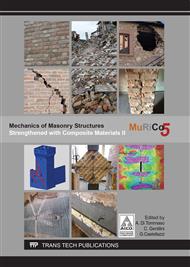p.334
p.342
p.350
p.358
p.366
p.374
p.382
p.390
p.398
The Use of Carbon Fiber Cementitious Matrix Connection for the Strenghtening of Multiple-Leaves Masonry
Abstract:
The paper reports the results obtained by a numerical investigation carried out on a multi-ple leaf masonry characterized by very poor inner core leaf in mortar and stone aggregate strengthened by innovative technology based on the use of composite materials. The scope of the study is to predict and simulate the real performance of the masonry when re-inforced by means of Carbon fiber connector. The proposed reinforcement technology consists in inserting some transversal C-FRP joints through the thickness of the wall. All the connection joints were inserted by a constant distance along the height of the masonry wall. The joints consist of a bundle of unidirectional long fibers held by a special mesh and inserting in the thickness of the wall by means of a cementitious matrix. The ad-vantages of having replaced an epoxy resin with cementitious matrix are multiple and re-gard, on one hand an increase in the reinforcement capacity and on the other an improve-ment regarding the problem of the durability of the structural reinforcement which for FRPs is a real. To this aim, a finite element investigation was carried out, firstly, on the original non-reinforced masonry then on the reinforced model both subjected to eccentric loads. This scheme of load is very common in practice due to eccentricity of the self-weight resultant of the top storey when the thickness is reduced in respect to the ground floor.
Info:
Periodical:
Pages:
366-373
Citation:
Online since:
July 2017
Authors:
Price:
Сopyright:
© 2017 Trans Tech Publications Ltd. All Rights Reserved
Share:
Citation:


